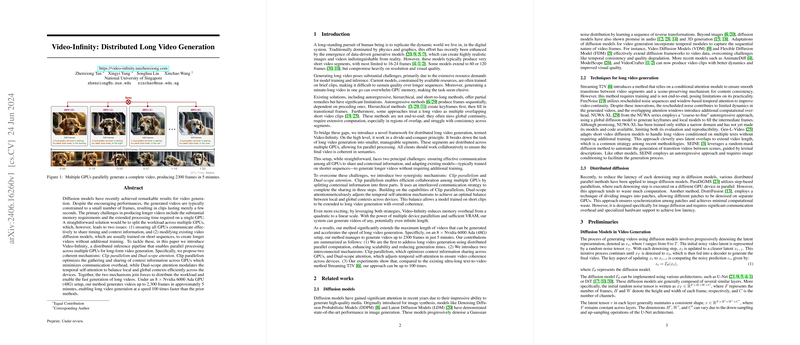Overview of Video-Infinity: Distributed Long Video Generation
This paper introduces a novel framework named Video-Infinity, designed to address the significant challenges in generating long-form videos using diffusion models. The paper addresses two primary obstacles: the substantial memory requirement and the extended processing time when using a single GPU for long video generation. By leveraging multiple GPUs, Video-Infinity offers a distributed approach to efficiently generate lengthy videos.
Challenges in Long Video Generation
The rise of diffusion models has marked a significant milestone in video generation, particularly with models like DDPM and LDM demonstrating impressive results. However, most of these models are confined to generating short video clips (16-24 frames), primarily due to the high memory demands and computational costs when extending to longer sequences.
Existing methods to extend video length include autoregressive, hierarchical, and short-to-long strategies. However, these approaches face several limitations, such as lack of end-to-end integration, high computational load, and difficulties in maintaining global consistency across video segments.
The Video-Infinity Framework
Video-Infinity overcomes these challenges by implementing a distributed inference pipeline, which parallelizes the video generation process across multiple GPUs, leveraging two innovative mechanisms: Clip parallelism and Dual-scope attention.
Clip Parallelism
Clip parallelism enables efficient workload distribution among multiple GPUs. It segments the input video latent into smaller, manageable clips, each processed on a different GPU. This mechanism minimizes communication overhead while ensuring the synchronization of context information among GPUs. Each GPU processes its segment in three stages:
- Broadcasting global context information to all devices.
- Exchanging local context information with neighboring GPUs.
- Final synchronization to ensure all devices have the required context for processing.
Dual-Scope Attention
The Dual-scope attention mechanism optimizes the temporal self-attention in video diffusion models by balancing local and global contexts. This is achieved through:
- Local Context: Gathering key and value pairs from neighboring frames, ensuring the continuity of immediate temporal information.
- Global Context: Incorporating key and value pairs from frames sampled across the video to maintain long-range temporal coherence.
By interleaving local and global contexts, Dual-scope attention enhances the coherence of extended video segments without requiring additional model training.
Experimental Results and Comparative Analysis
The efficacy of Video-Infinity was demonstrated using a setup of 8 Nvidia 6000 Ada GPUs. This arrangement successfully generated videos up to 2300 frames (approximately 95 seconds at 24 fps) in just 5 minutes, showcasing significant improvement over previous methods.
Performance Metrics
Video-Infinity was evaluated against existing methods, including FreeNoise, Streaming T2V, and OpenSora V1.1. The results highlighted its superior performance in terms of both capacity and efficiency:
- Maximum Frame Capability: Video-Infinity can generate videos up to 2300 frames, surpassing others by a substantial margin.
- Generation Speed: It was 100 times faster than Streaming T2V for generating 1024-frame videos.
- Video Quality: Evaluated using VBench metrics, Video-Infinity maintained high-quality scores across various dimensions, including subject consistency, motion smoothness, and dynamic degree.
Theoretical and Practical Implications
The introduction of Video-Infinity has significant implications for both theoretical advancements and practical applications in AI-driven video generation:
- Scalability: The distributed approach enables the generation of much longer videos without compromising quality, paving the way for scalable video generation technologies.
- Efficiency: By effectively distributing computational loads and optimizing communication strategies, this method reduces processing times, making long video generation more feasible for real-world applications.
Future Directions
The paper opens several avenues for future research:
- Enhanced Synchronization Techniques: Further improvements in inter-GPU communication protocols could minimize latency and increase efficiency.
- Adaptation to Different Architectures: Adapting the principles of Clip parallelism and Dual-scope attention to other model architectures could expand its applicability.
- Handling Scene Transitions: Developing mechanisms to handle smooth transitions between distinct scenes within long videos could enhance the overall utility of the method.
In conclusion, Video-Infinity presents a substantial advancement in the domain of long-video generation, addressing critical limitations of existing methods through innovative distributed processing techniques. Its contributions lay foundational work for future developments in efficient, scalable video generation using AI.
